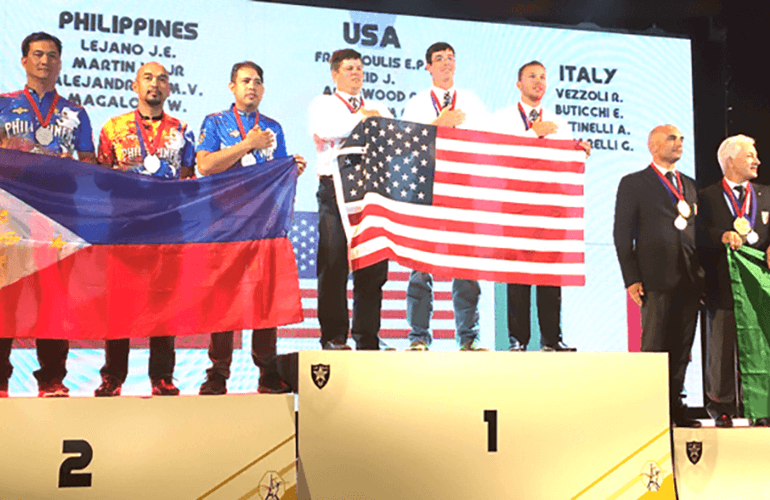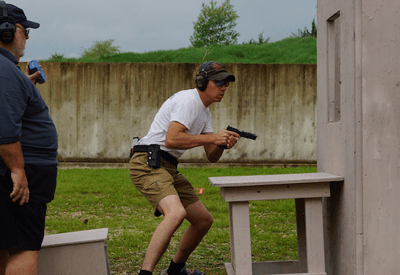Q&A with 2017 Team USA Classic / Single Stack shooter Jeremy Reid
Posted by Ben Stoeger Pro Shop on Sep 18th 2017

How did you train leading up to the World Shoot and how was that different than training for USPSA?
The IPSC World Shoot is the pinnacle of our sport; so the opportunity to be able to compete there was a huge honor and one that I felt deserved the best effort I could give. The World Shoot has been the focus of my training from the time I found out I would be on the US Classic team about a year ago. For me, that meant that I would be shooting Single Stack all year. Normally I would switch over to Limited division after Single Stack Nationals was finished, however this year I stayed with Single Stack. Another strategy I used was to shoot turtle targets year round, rather than standard metric targets usually used in USPSA. Two major differences in IPSC and USPSA are the hit factors of stages and distance of target presentations. Typically speaking, IPSC matches have quite a bit lower hit factor stages than what we are used to in the States. I assumed that the target presentations at the World Shoot would incorporate more distance, and they did indeed extend beyond what we have become accustomed to being challenged with by USPSA matches. That being the case, points become quite a bit more critical, as such I put a large emphasis on basic fundamentals in my training. IPSC also does not have the arrays/clusters of targets that is typical at a USPSA match, so your entries and exits become more crucial, as well as wide transitions. In all honesty this is very typical to how I normally train, which is why I partially think that IPSC matches are more interesting to me. The biggest strategy I tried to employ differently this year was to simply train harder than I normally do. I was not able to get the number of rounds downrange that I had planned on, going into the year; however I did feel adequately prepared.
Now that you have shot the World Shoot, how do you wish you would have trained differently?
I really wish I could have shot more matches leading up to the World Shoot. I feel like my shooting was solid enough going into the match that I had the potential to win the match. However, I did not have the confidence that I should have had that my skills would hold up under match pressure. I wish I had had more opportunities to perform under match stress.
Additionally the one skill that I did not feel I prepared for adequately was shooting on the move. The World Shoot had several wide-open stages that gave you the opportunity to gain some time if you were willing to shoot on the move. The risk shooting minor was how many points you might drop vs. shooting static. I chose to shoot static most of the time because I had not trained shooting on the move enough to be confident that I could shoot A’s in that 12-15 yard distance.
How will you change your training for future IPSC matches?
My training for this match was almost strictly shooting. This match was a fairly physical match that required endurance and the ability to move well on your feet. For future international matches I plan to improve my overall strength as well as working on foot speed and agility drills–channeling my inner JJ.
How does the lack of pre-match stage inspections and shorter walkthroughs (3, 4, 5 Minutes) affect your match?
For the most part the shorter walkthroughs are not a big issue. There weren’t any “memory” stages in the match, so a longer walkthrough was not as necessary. The squads were fairly large,16 shooters per squad, which did encroach on your ability to adequately get your time in on the walk through. The first stage of the match was a medium course, in a fairly confined shooting area. I happened to be the 2nd shooter up for this stage. After taking about two minutes to try and figure out where all of the targets were, I simply did not have a good idea for a plan. Not a good way to start the World Shoot. Fortunately at this match we were shooting as a Team as well as individuals, and I was able to ask my good buddy and teammate Randy Arrowood if he had a plan. He was able to give me a quick breakdown of the stage. I burned it into memory as quickly as possible. It was quickly my turn to shoot, but I was at least able to know where the targets were and where I needed to reload. I would have been in a little bit of trouble if Randy hadn’t been able to help me out on that one. There was one other large field course where I wish I had had more than the 5 minutes. On this particular stage there were five windows to shoot from. Option A was to go to all five positions and shoot the targets from closer up. The disadvantage here was that you had to travel a longer distance. Option B allowed for one less shooting position, and quite a bit less distance traveled; however, Option B required you to “hunt and peck” a little bit, with targets that were further away, and you had a standing load. I was the first shooter on the US Team to shoot and I opted for Option A. As soon as I finished shooting and heard my time I knew that I had picked the wrong option, and I was able to tell the rest of the US Team to take Option B. Option B saved about 3 seconds. If I had had more time to look at both options, I probably would have gone with Option B. The challenge with the short walkthroughs is that you really have to just find a solid plan and commit to it as soon as possible. Even with that you may only get one or two looks at the entire stage.
Did you have to modify your gun to make it IPSC legal, and if so how long did you train with that configuration?
IPSC and USPSA rules for Classic and Single Stack are quite similar. The IPSC box is a little bit smaller than the USPSA box. For me that only means a slightly different basepad for my magazines. In practical use, I cannot tell a difference in the two. I did not change the basepads until about a week before I left. In IPSC the magwell dimensions are a good deal smaller than what is allowed in USPSA. Luckily with Techwell grips switching magwells is very simple. I used the IPSC legal magwell the entire year. The last difference that affected me was that there is not a weight limit in IPSC Classic division. This allowed me to run grips made by Techwell that are hollowed out, so that you can add some lead shot. I only practiced with the heavier gun for a couple of practice sessions before I left.
Does the mixture of short, medium and long courses affect your approach to the match?
I really enjoy the IPSC stage layouts. It puts a little more pressure on the long courses as there are so few stages with that many points to be gained or lost. You also can’t just lay back on the short courses because there are so many of them, you really have to stay aggressive. The medium courses are the real “meat and potatoes” of the match. At the World Shoot, points were absolutely paramount on the medium courses. Having a reduced number of rounds, but still being on a large field course, the hit factors were fairly low. When that is the case, more emphasis needs to be placed on solid hits, as points down are worth more time than in a high hit factor stage.
What surprised you at the World Shoot?
I can’t say that there was a lot from a shooting perspective that was much of a surprise. Some of the food and culture was a bit of a surprise, and I think everybody from the US was a little surprised at the scarcity of ice. You can’t find it anywhere except maybe the butcher at the local grocery store. They also eat very little meat, but massive amounts of bread. That was kinda hard on this Texas boy. My biggest surprise of the match was probably the people my wife and I were able to meet. We gained several new friends from all over the US and the world really. The length of this match and the team aspect of it really changed the overall atmosphere. We are already looking for ways to be able to get to some different matches than we would normally shoot here in the US and trying to figure out how we can shoot a few more matches internationally in the future.
Do you plan on shooting more IPSC matches?
I would really like to. I really enjoy IPSC style matches. Like I said before, we have some new international friends that we would enjoy being able to visit. The Infinity Open has always looked like a cool match. If we can find a way to make that happen, we will.
What advice would you give someone interested in shooting a match internationally?
Be diligent ahead of time. Make sure you research the firearm laws in the country you are traveling to, (or through via layover). Get all of that straightened out well in advance of your trip. The last thing you want to be doing right before you leave is to be stressing out about legal details. This also includes making sure all of your gear is IPSC legal. I also recommend simply going and doing it. I think that may be the hardest part. Seeing and experiencing something outside of the USA may widen your viewpoint, and at the same time really help you to appreciate what we have here in the US.
Jeremy Reid
USPSA Grand Master
2017 US World Shoot Team Member
http://www.reidpistolsmithing.com/
Reid Pistolsmithing Facebook
Reid Pistolsmithing Instagram


